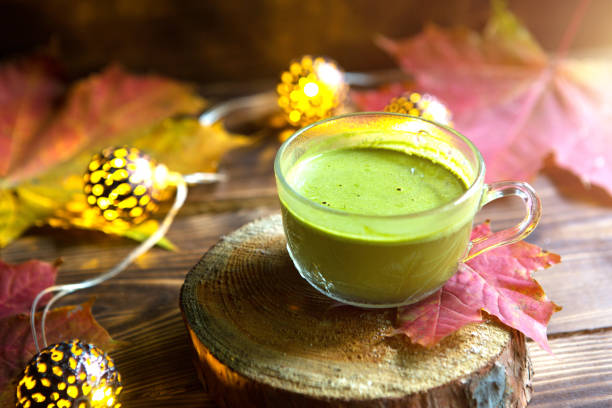Welcome to my article about “When To Drink Matcha Tea?”. Matcha, often known as the “wholesome powerhouse,” is a vibrant green tea powder that has captivated the wellness community worldwide. Its origins go back centuries, deeply rooted in Japanese culture, where monks and samurais cherished it for its calming and energizing qualities. Unlike regular green tea, matcha is made from finely ground whole tea leaves, providing a more potent source of nutrients and antioxidants.
This exceptional beverage is notable for its abundant content of catechins, particularly EGCG (epigallocatechin gallate), which is renowned for its powerful antioxidant properties. The body’s free radicals are combated by these antioxidants, leading to improved health and a lowered likelihood of chronic illnesses. Additionally, matcha contains L-theanine, an amino acid that promotes relaxation without causing drowsiness, making it suitable for individuals seeking mental clarity and focus. Paired with moderate caffeine, matcha offers a calm, sustained energy boost, unlike the jittery effects often associated with coffee.
The historical importance of matcha is significant and should be considered. It has been a crucial part of Japanese tea ceremonies, symbolizing mindfulness, respect, and tranquility. These “chanoyu” ceremonies highlight the art of preparing and drinking matcha, stressing the importance of being present and savoring each sip. This cultural legacy adds depth to matcha’s appeal, linking present-day consumers with age-old traditions.

From a nutritional perspective, matcha is a nutritional powerhouse. It is high in vitamins A, C, E, K, and B-complex and minerals like potassium, calcium, and magnesium. These nutrients support immune function, skin health, and bone strength. In addition, matcha includes fiber that aids digestion and regulates blood sugar levels, which makes it a nutritious complement to any diet.
As we explore the benefits of matcha in greater detail, we will discuss the best times to consume this exceptional tea to maximize its effects. Whether you want to start your day with a burst of energy, improve your workout performance, or find a moment of tranquility in the afternoon, matcha is suitable for every part of your day. Understanding when and how to include matcha in your routine can help you unlock its full potential and embrace a balanced, healthy lifestyle.
In this piece, we’ll discuss matcha’s countless benefits, shedding light on its nutritional content and historical importance while offering practical advice for its consumption. Prepare yourself for an adventure that will excite your palate and improve your health. Welcome to the universe of matcha, where tradition intersects with modern wellness.
Understanding Matcha’s Caffeine Content
Regarding caffeine content, matcha provides a distinct and well-rounded experience compared to other types of tea and coffee. Understanding the intricacies of matcha’s caffeine levels can help you make informed decisions about integrating this potent green tea into your daily regimen.
The caffeine content in matcha is around 30-35 mg per gram, less than the caffeine found in an average cup of coffee, which usually has about 95 mg per cup. However, this comparison doesn’t tell the whole story. Unlike coffee, which can cause a quick increase and subsequent drop in energy levels, matcha offers a more steady and prolonged energy boost. This is attributed to the time-release nature of its caffeine, a distinctive quality linked to the presence of L-theanine, an abundant amino acid in matcha.
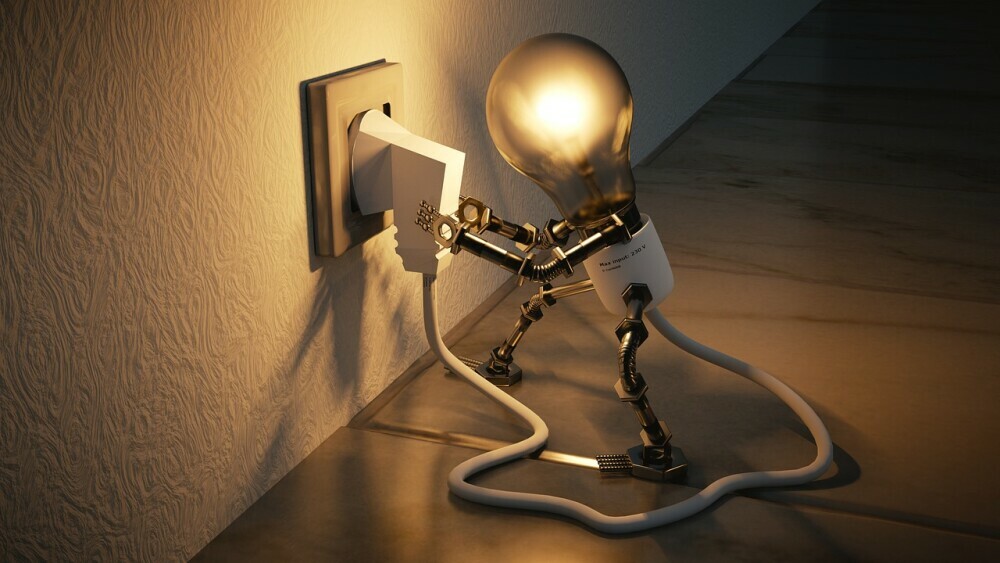
Combining caffeine and L-theanine in matcha produces a collaborative effect that enhances alertness and concentration without the nervousness often associated with coffee. L-theanine boosts alpha brain wave activity, inducing a state of relaxed alertness. This means that individuals who consume matcha can experience a calm, sustained energy lift that lasts longer, aiding them in maintaining productivity and focus throughout the day.
For those who are sensitive to caffeine, comprehending the effects of matcha is vital. Although the caffeine content in matcha is generally lower than that of coffee, its time-release nature may make the energy boost feel more manageable and less overwhelming. However, individual tolerance levels vary, so monitoring how your body reacts to matcha is crucial. Start with smaller servings and slowly increase your intake to discover the perfect balance.
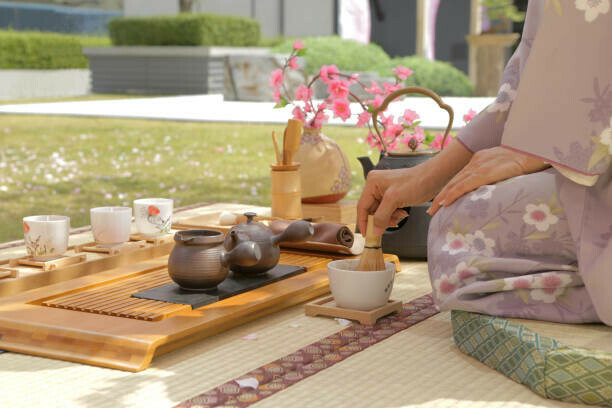
Timing is also essential when consuming matcha, particularly for individuals sensitive to caffeine. To avoid potential sleep disturbances, consuming matcha earlier in the day is recommended. Having matcha in the morning can help kickstart your day with sustained energy, while midday serving can offer a gentle pick-me-up to get you through the afternoon slump. It’s advisable to avoid drinking matcha in the late afternoon or evening to promote a peaceful night’s sleep.
Feel free to incorporate matcha into your everyday schedule as a pleasant method of experiencing its unique advantages and efficiently controlling your caffeine consumption. Whether you’re seeking to enhance your morning routine or find a healthier alternative to coffee, matcha provides a balanced, refreshing, and mindful approach to staying energized and focused. Embrace the influence of matcha and explore a new way to power your day with natural, time-released energy that leaves you feeling your best.
Best Times to Drink Matcha for Energy and Focus

Matcha has rapidly become a go-to choice for individuals searching for a natural way to increase energy and concentration. Its bright green color and earthy taste are just the start of its appeal. A strategic method can have a notable impact on the best times to consume matcha to maximize its benefits.
Starting your day with matcha is an excellent decision. The consumption of matcha as a morning drink boosts your energy levels and creates a favorable start to your day. In contrast to coffee, which can lead to a sudden surge and subsequent drop in energy, matcha provides a more consistent, enduring lift. This is because of its distinctive combination of caffeine and L-theanine, an amino acid that encourages relaxation and improves mental clarity. Having matcha in the morning can help you feel alert and focused without the nervousness accompanying other caffeinated beverages.

In addition to its morning advantages, matcha is also an exceptional pre-workout supplement. Athletes and fitness enthusiasts are progressively turning to matcha for its ability to enhance performance and stamina. The caffeine in matcha can improve exercise capacity and decrease perceived exertion, making your workouts more manageable. Additionally, the antioxidants in matcha aid in reducing inflammation and expediting recovery post-exercise. Drinking matcha about 30 minutes before your workout can provide the ideal energy boost to power through even the most intense sessions.
Balancing your matcha consumption is crucial to maintaining sustained energy throughout the day. One serving in the morning and another in the early afternoon can keep your energy levels steady without overwhelming your system. This approach helps to avoid the midday fatigue that many people experience. Matcha’s slow-release caffeine ensures you stay alert and productive without needing constant refueling.
Nonetheless, it’s essential to be cautious about consuming matcha to prevent potential sleep disturbances. Drinking matcha late afternoon or evening can disrupt your sleep cycle, as the caffeine can linger in your system for several hours. To ensure a restful night’s sleep, limiting your matcha intake to the earlier parts of the day is best. This way, you can enjoy matcha’s energy-boosting properties without sacrificing sleep quality.
Integrating matcha into your daily routine can significantly enhance your energy and focus. Whether you’re using it to kickstart your morning, fuel your workouts, or maintain consistent energy levels throughout the day, matcha offers a versatile and healthful option. By understanding the most advantageous times to drink matcha, you can optimize its benefits and enjoy a more energized and focused lifestyle.
Matcha Rituals: Aligning with Natural Rhythms
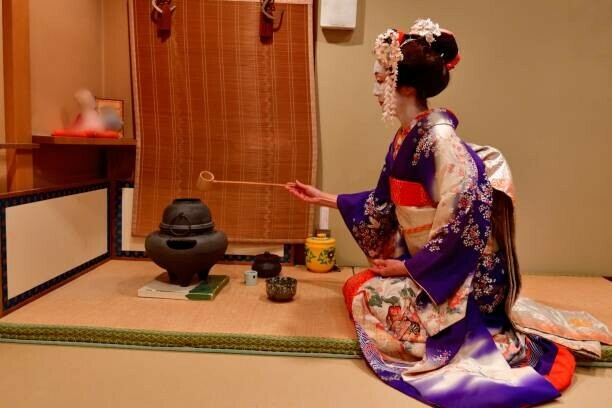
The ancient Japanese tea ceremony, known as “chanoyu,” harmoniously combines art, culture, and mindfulness and has been observed for many generations. At the core of this ceremony is matcha, the vivid green tea powder that provides various health benefits and serves as a central element for meditative practice. Embracing the contemplative aspects of the tea ceremony can turn the simple act of drinking matcha into a meaningful ritual that aligns with natural rhythms and supports overall well-being.
In a traditional tea ceremony, every movement is intentional and significant. Preparing and consuming matcha is deliberate, systematic, and deeply respectful of the tea’s origins. This mindful approach encourages participants to be completely present in the moment, savoring the matcha’s textures, scents, and tastes. By integrating these components into your practice, you can generate a feeling of tranquility and concentration beyond the tea ceremony itself.
Integrating matcha into a mindfulness regimen can be a potent way to enrich your daily schedule. Start by setting aside a few minutes each day to prepare your matcha with purpose. Utilize a bamboo whisk to froth the matcha powder into a smooth, velvety texture, paying close attention to the sensory experience. As you sip your matcha, take unhurried, deliberate breaths and allow yourself to thoroughly enjoy the flavor and aroma. This uncomplicated practice can ground you in the current moment, lessening stress and improving mental focus.
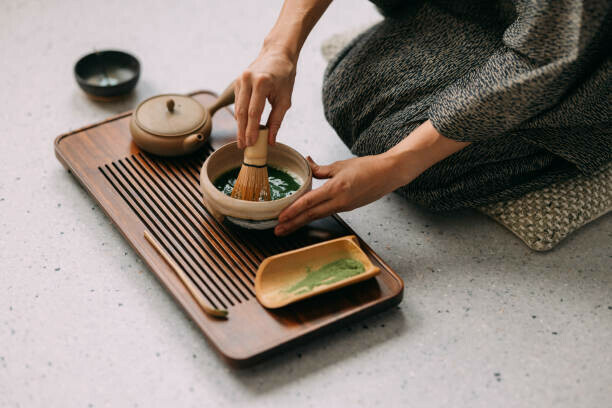
Aligning your matcha consumption with your circadian rhythm can further maximize its advantages. The circadian rhythm, also known as your body’s internal clock, regulates sleep-wake cycles and other physiological processes. Drinking matcha in the morning can help you synchronize with this natural rhythm, providing a gentle, sustained boost of energy that prepares you for the day ahead. Similarly, enjoying matcha in the early afternoon can help combat the post-lunch energy slump, keeping you attentive and focused without disrupting your sleep cycle.
Crafting personalized matcha routines for holistic wellness enables you to tailor the experience based on your distinct requirements and tastes. Whether you prefer to savor your matcha in the peaceful solitude of the morning or as a communal experience with loved ones, the core is to approach it with mindfulness and purpose. Consider integrating other well-being practices, such as writing in a journal or gentle stretching, into your matcha ritual to further amplify its benefits. Making matcha a consistent element of your everyday schedule can help you cultivate balance and peace, contributing to your general health.
By embracing matcha’s meditative and mindful aspects, you are not just drinking a beverage; you are taking part in a tradition that has been cherished for centuries, honoring the beauty of the present moment. Through these rituals, you can connect more profoundly with yourself and the natural world, cultivating a sense of peace and well-being that resonates throughout your life.
Navigating Matcha Side Effects and Best Practices

Matcha is a popular drink in wellness circles due to its numerous health benefits. However, it’s essential to consume matcha mindfully by being aware of potential side effects and best practices. This ensures that you can enjoy the many advantages of matcha while minimizing any adverse reactions.
One possible side effect of matcha is digestive sensitivity. The high levels of antioxidants and caffeine in matcha can occasionally lead to stomach discomfort, especially if consumed on an empty stomach. To address this, it’s recommended to have a small meal or snack when consuming matcha to prevent overwhelming the digestive system. Paying attention to how your body responds is crucial. If you consistently experience discomfort, adjusting the timing or amount of matcha you consume can make a significant difference.
Adapting matcha intake based on personal health conditions is another crucial factor. For individuals with conditions such as acid reflux, anxiety, or certain heart conditions, the caffeine in matcha can worsen symptoms. It’s always wise to seek advice from a healthcare provider before making matcha a part of your routine if you have any underlying health issues. They can offer personalized advice on enjoying matcha safely, ensuring that it complements your health rather than causing complications.
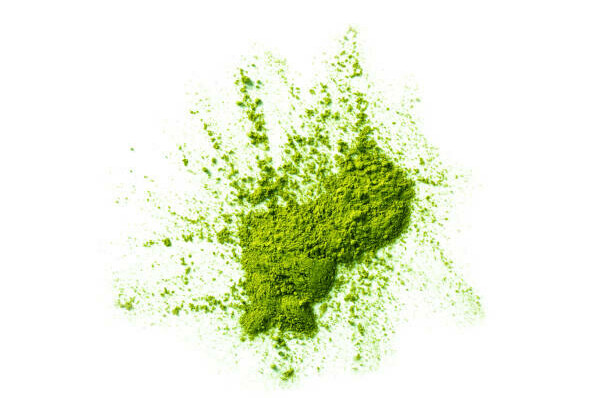
The significance of selecting high-quality matcha products cannot be overstated. Various grades of matcha are available, and choosing ceremonial-grade matcha ensures that you’re consuming a product free from additives and impurities. High-quality matcha is more enjoyable and beneficial, providing a purer source of antioxidants and nutrients. Seek out well-known companies that obtain their matcha from traditional tea-producing areas in Japan, like Uji or Nishio. These areas have a long-standing reputation for producing superior matcha, reflecting their dedication to quality.
In summary, mindful consumption of matcha is more than just about drinking a trendy beverage; it’s about incorporating a practice that enhances your overall well-being. By recognizing and addressing potential digestive sensitivities, adjusting your intake based on personal health conditions, and selecting high-quality matcha products, you can fully enjoy the benefits of this powerful green tea. Embracing a mindful approach to matcha consumption allows you to enjoy its energizing and soothing effects that align with your body’s needs. The thoughtful strategy guarantees that matcha remains a beneficial part of your everyday schedule, promoting a well-rounded and health-conscious way of life.
Thank you for reading my article about “When To Drink Matcha Tea?”, and I would love to receive your comments down below, in case of any.

